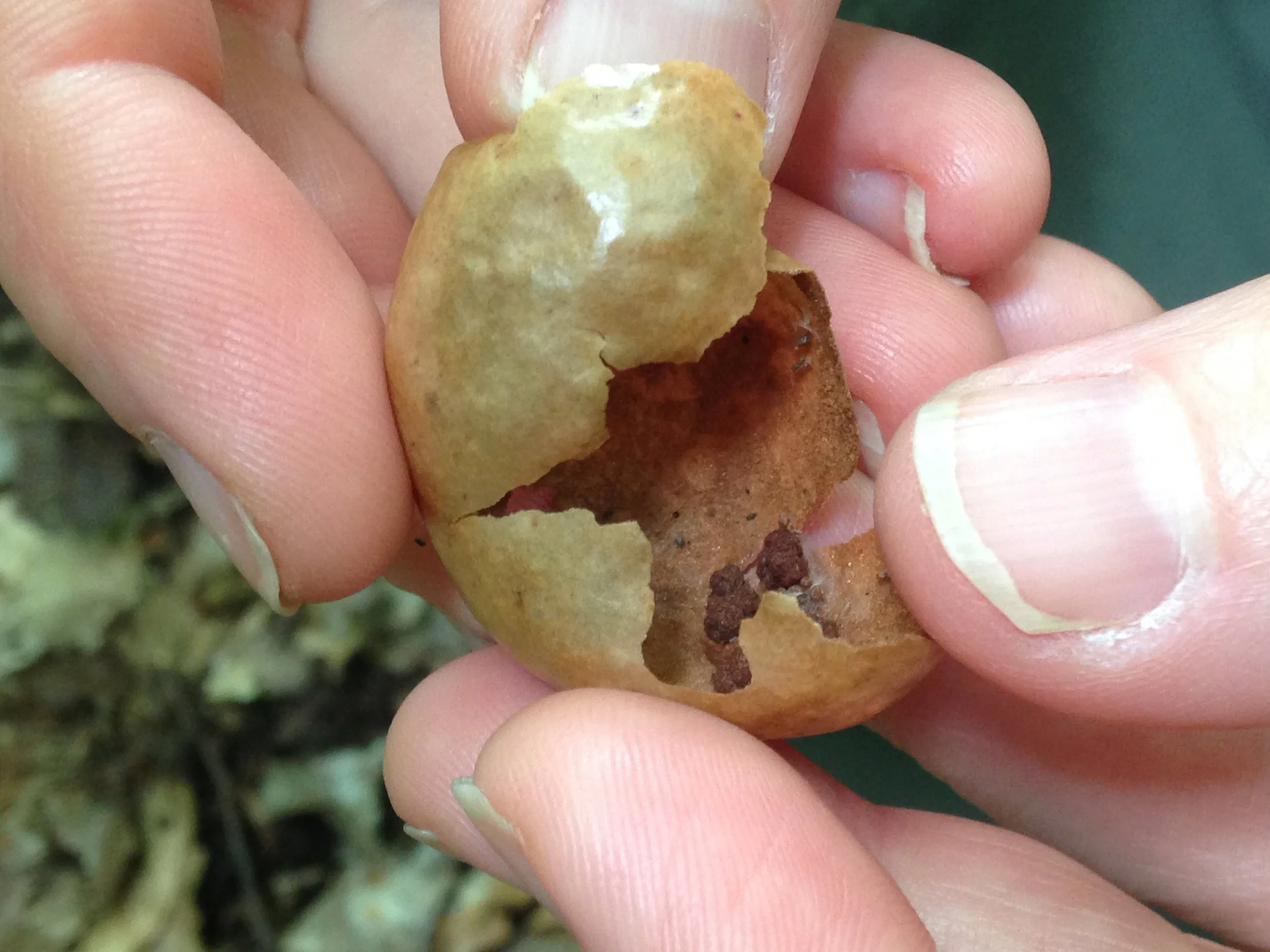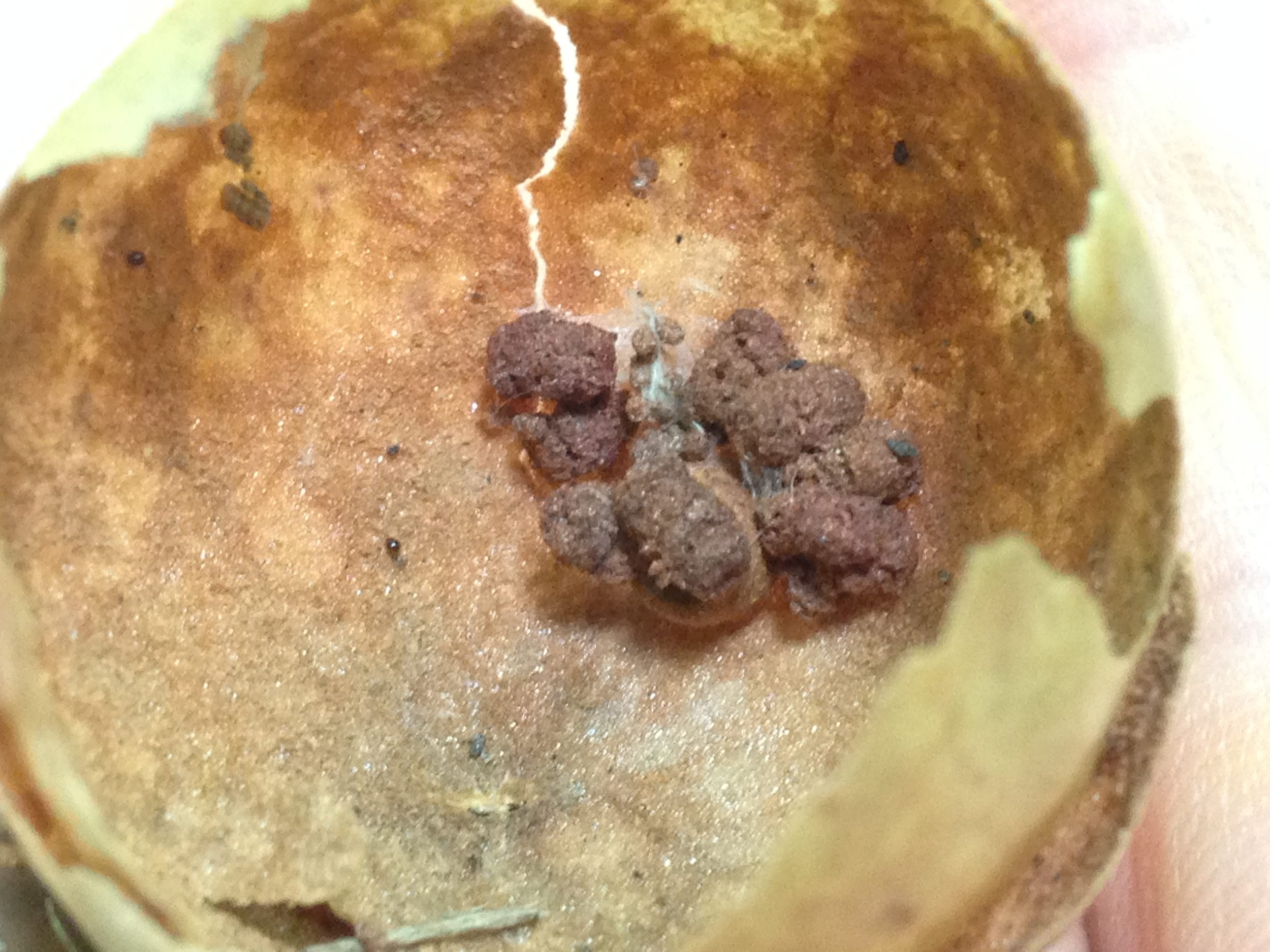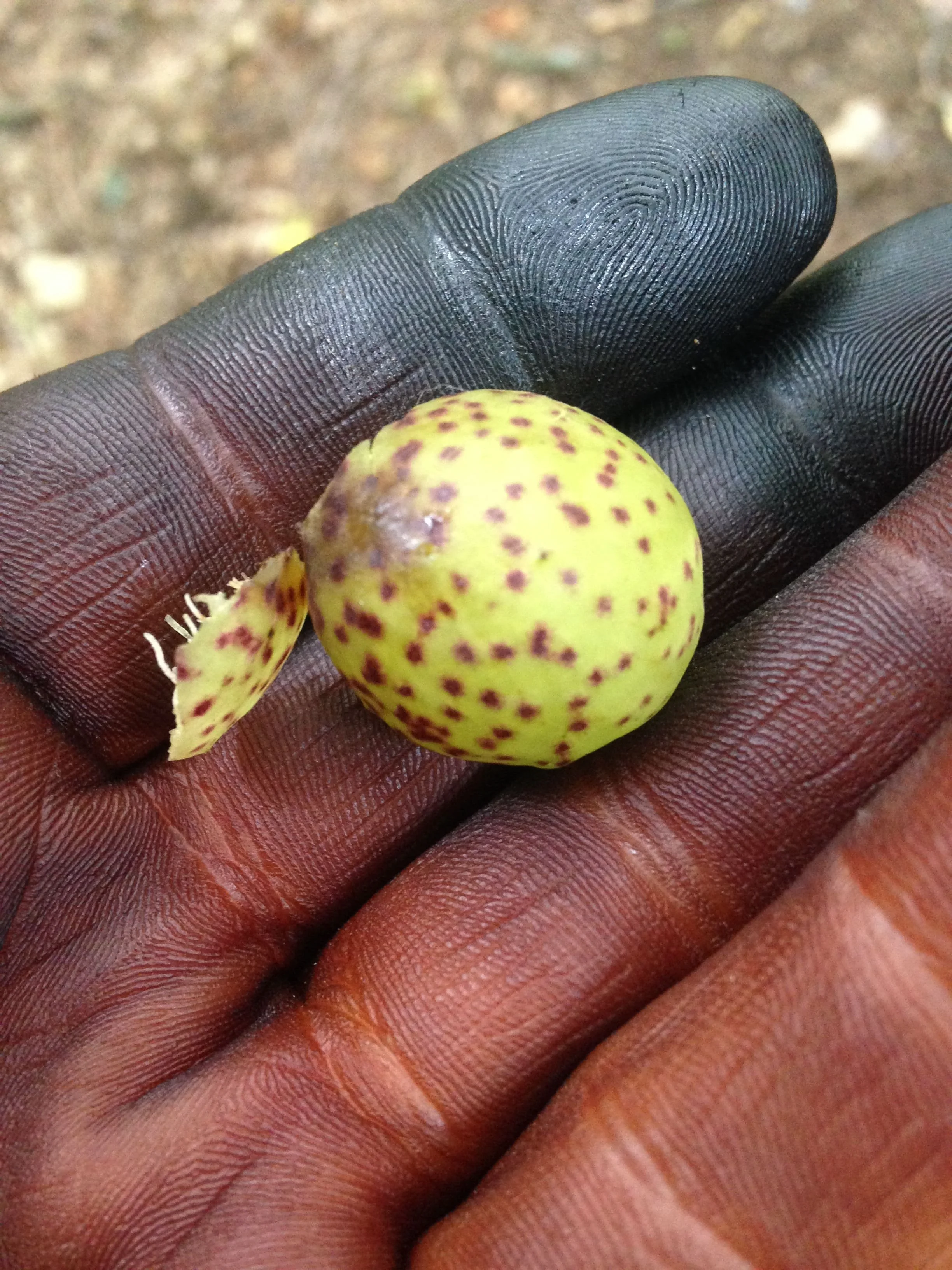Oak Apple Galls at Lake of Bays
Have you ever gone to a party and you recognized someone who walks in, and you know their name, but not really know anything about them? I’ve been in these situations before, where I see someone interesting and I get curious as to who they are, who they know at the party and what their story is. In these situations, I tend to go about my business but I am also aware of their interactions if they are close by, I note who they might be talking to, what songs they like and what makes them laugh. If they seem like a jerk, I tend to steer clear, but if they seem cool I might go introduce myself. This sort of observation, consideration of relationships and how a form of life makes their way in the world is similar to how I approach the non-human world as well. When I see something interesting or new to me, I get curious. I try and pay attention to where the phenomena took place, and who is affected by it. Who does this life consume? Who in turn consumes them? What conditions are best suited for something to grow? Are they harming something or is there a mutualistic relationship happening? My observations in the field can only go so far, so I then turn to research. This is the story of that research.
Oak Apple Gall found at Lake of Bays, 2022.08.13
Oak Apple Gall found at Backus Woods, 2021.08.25
Someone in our tracking crew had found a small, pale brown, hollow papery orb with spots on the surface with a couple of holes in it. I recognized it as an Oak Apple Gall, which my partner and I had found last year at Backus Woods.
It wasn’t a green one, but it must be the same thing, right?
Last year, I may have looked up a bit on the Oak Apple Gall, but I no longer remember much. It’s like meeting someone again, but not remembering much of the details of your previous conversation. I had to ask some questions again, and here is some of what I have learned.
Oak Apple Galls are, like other galls, abnormal growths or swelling induced by the interaction of an aggravating life form with the plant. Those life forms could be an insect, a mite, a fungi, bacterium, nematode, or even a virus. The plant releases growth hormones and chemicals to quickly form thick tissue growth around the animal, fungi, or bacteria which is interacting with the plant. While galls can sometimes be harmful for the plant host, they aren’t always. Some are benign, some may even be beneficial.
There are a couple of Oak Apple Galls caused by a few different species across many genera. The particular gall we found was large, empty, green with purply spots, around 3 cm (1¼ in) in diameter and was made by Amphibolips quercusinanis, which is another species of wasp found in the Gall Wasps, or Cynipidae family. This particular gall is called the Empty Oak Apple Gall (I love when life forms get simple names that describe them well), and they grow along the midrib or middle vein on the underside of Scarlet Oak (Quercus coccinea) and Red Oak (Quercus rubra) leaves, and in the case of the forest we were in, it was full of Red Oaks. The leaves are often deformed or aborted.
The adult Amphibolips quercusianis lays an egg on the leaf bud in the Spring. Then, as the leaves unfold, the egg hatches and larva burrows their way into the midrib of the leaf, and there, through either chemical interaction, or the irritant of the egg or the burrowing larva, the leaf reacts by isolating the larva within the gall.
There are also Oak Apple Galls with a soft juicy tissue filling the inside except for a small cell in the middle where the developing larva hang out. These are called Spongy Oak Apple Galls, and are created by the wasp Amphibolips confluenta. I have yet to encounter this kind of gall.
The Cynipidae family of wasps is all about the galls. There are about 1,000 species worldwide and they all make a gall specific to their species. Not only that, but some Cynipidae family members have alternating generations of only female offspring which make a specific kind of gall, and then a generation of both male and female offspring, which make a different kind of gall! Some members of the Gall Wasp family don’t even make their own galls, but instead find another gall made by another Gall Wasp and move in, feeding on the gall tissues. These Gall Wasps are awesome.
A couple of pages from “Fifty Common Plant Galls of the Chicago Area” by Carl F. Gronemann (Field Museum of Natural History, 1930).
In Doug Tallamy’s book “The Nature of Oaks”, he asks the question as to why the Oaks would allow, over millennia of co-evolution and natural selection, the Gall Wasps to continue to infest the trees, while the Oak does all the work for the larvae, making shelter and food? Why isn’t the Oak looking out for itself? Turns out Doug has a theory:
Cynipids are herbivores that feed within plant tissues. Let’s imagine for a moment that galls did not form around cynipid eggs and larvae. In that case, the larvae would not concentrate all their feeding in one location as they do within a gall; instead, they would tunnel through leaves or stems over a much wider area, very likely damaging oak vascular tissues as they went. With no physical constraints on their feeding, selection might have favored large individuals, larger than what can be achieved within galls, which would have, in turn, led to even more tissue damage to oaks from cynipids. Rather than thinking of galls as one-sided adaptations that favor only cynipids, we might more accurately view them as an evolutionary compromise that confines cynipid herbivory to one tiny site, minimizing damage from cynipid herbivores, and constraining the size of these oak parasites, while galls simultaneously allow cynipids to complete their development within the relative safety of a gall.
Image from Cynipid galls of the eastern United States by LH Weld (1959)
In a video online, Tom Wessels, a terrestrial ecologist who I am a very big fanboy of, describes how coevolved species tend to start to work together if given a long enough time span. Energy efficiency seems to win out in the natural world and he relates this idea to the Oak Apple Gall as well. He was wondering, like Doug Tallamy above, why the Oak creates these large galls on the leaves when the formation of the gall is using up so much energy? It would seem counter intuitive if we remember that nature does not appreciate the wasting of energy. Tom suggests in the video that the plant tissue which makes up the gall is still photosynthesizing while also protecting the larva living safely within. This energy production is equal to or more so than the amount of energy that is embedded within the gall. He then suggests that if the energy production is greater than what the intact Oak leaf would have produced without the gall, then the gall, with increased energy production capacities could actually benefit to the tree. So it seems that two biologists are seeing these galls as potential boons for the trees as opposed to simply parasitic relationships which have been suggested in the past.
So now that we know a little bit more about the Amphibolips quercusianis Gall Wasps, the gall structure and the energy output/input, why does the gall we found look different from the ones in the pictures on the internet? All the Empty Oak Apple Galls on the internet show a thin walled green orb with purplish spots on the outside, with long filamentous strings supporting a small chamber in the middle where the larva live. When Tamara cracked ours open, the one we found was mostly hollow.



Why does the gall we found look different? Why papery and brown? Why no filamentous strings? No larval chamber? And what’s with the brown stuff? My research is teaching me that as the larva matures, they depart from the gall and then the gall changes colour from green to the caramel brown, and the gall becomes dry and brittle. What I am curious about is that the gall we found didn’t have the radiating filamentous strings, yet there are photos online of mature brown galls with the strings still intact (1)(2). I have also read (but without sources) that the Gall Wasp larvae do not defecate while growing in the gall, yet the gall we found appears to have frass (insect poop) within it.
Adding these clues together, no filament + presence of poop, I get to wondering if another insect may have preyed upon the wasp larva within the gall? I read in one paper, that they observed two Earwigs in the genus Forficula (our common Earwig in Ontario is Forficula auricularia) emerging from the galls of Amphibolips quercusinanis a few days after they collected the gall. They suggested that since the Earwigs are nocturnal, they may have only been using the large, mostly-hollow A. quercusinanis galls to chill during the day. Did they poop in the empty gall? Did someone else? Regardless of whomever left the frass inside the Empty Oak Apple Gall there are records of other species inhabiting the galls alongside Amphibolips quercusinanis, so now I just need to find out any recorded predators of the A. quercusinanis and see if a predator is why the gall was truly emptied or if someone else came along after the A. quercusinanis matured and departed, and just spent the night and left behind some scat when they left? So many questions, but sometimes you’ve got to stop writing before they all are answered.
I have written this before but I appreciate that when I take the time to focus in on a subject more and more questions develop and emerge, and my research could go on and on and on. I understand more why different scientists get so specialized in their fields. The desire to know and to develop a depth in the relationship is very real. It’s not like there isn’t a desire for mystery and that unknowns are bad because that’s not what I want to imply. Rather, it is similar to when you’ve got a crush on someone and you spend a lot of time thinking about them, wondering about the possibilities and falling into deep curiosities. There is a lot of time in a relationship spent asking questions and getting to know each other, and I guess this is where I am in my getting to know you phase with the Oak Apple Galls.
To learn more :
Insects : Their Natural History and Diversity by Stephen A. Marshall (Firefly Books, 2006).
Tracks and Sign of Insects and Other Invertebrates by Charley Eiseman and Noah Charney (Stackpole Books, 2010).
Gallformers.org
The Nature of Oaks by Douglas W. Tallamy (Timber Press, 2021)
Interview with Doug Tallamy about the book “The Nature of Oaks”
Cynipid galls of the eastern United States by LH Weld (1959)
Cynipid Gall Wasps article from Current Biology 28, R1365–R1381, December 17, 2018
The Population Biology of Oak Gall Wasps
Tom Wessels video on “The Ecology of Coevolved Species”
Interview with Tom Wessels about his work
Apples Don’t Fall Far From The Oak Tree by Joe Boggs, Ohio State University Extension
The arthropod associates of 155 North American cynipid oak galls




